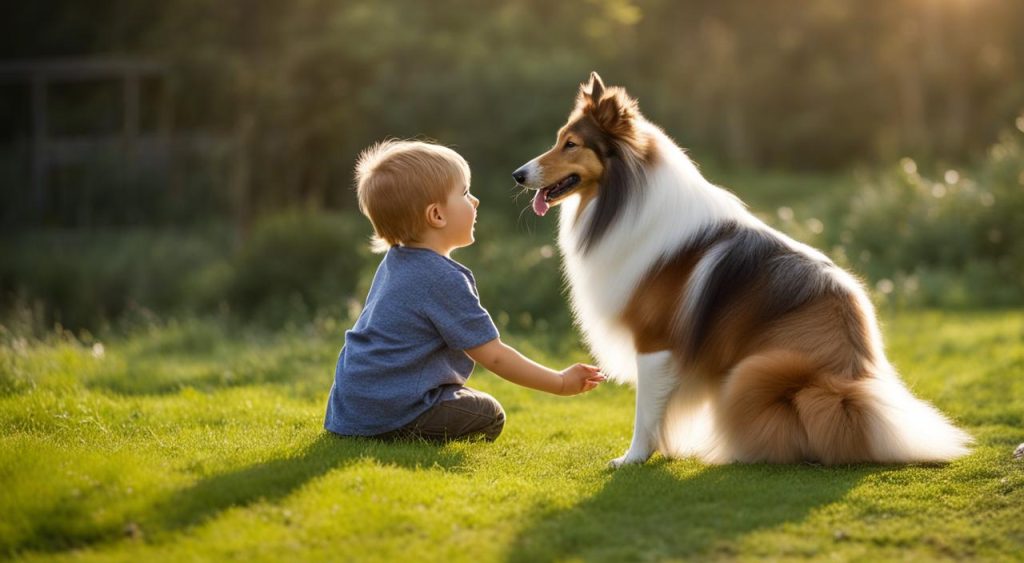Shetland Sheepdogs, also known as Shelties, are beloved for their charming appearance and intelligence. However, some Shelties exhibit a skittish nature, displaying anxiety and fearfulness in certain situations. Understanding the factors that contribute to this behavior can help owners better manage and support their Shelties.
Sheltie temperament plays a significant role in their skittishness. While shyness is not defined within the Sheltie breed standard, some individuals may display more reserve than others. This reserve can manifest as fearfulness and timidity, making Shelties prone to being skittish in unfamiliar or challenging environments.
One factor that impacts a Sheltie’s temperament is the temperament of its parents. If the parents display skittish behavior or anxiety, their offspring may be more inclined to exhibit similar traits. This genetic predisposition further emphasizes the importance of responsible breeding and selecting breeding pairs with stable and confident temperaments.
Early socialization plays a crucial role in shaping a Sheltie’s temperament and reducing skittishness. During the critical fear periods between 8 and 11 weeks old and between 6 and 14 months old, proper socialization can help a Sheltie build confidence and become more comfortable in various situations. Exposing them to new people, places, and experiences helps them develop positive associations and cope better with unfamiliar stimuli.
Training is also instrumental in managing skittish behavior in Shelties. Positive reinforcement techniques, such as rewarding desired behaviors and using calm and reassuring voices, can help build their confidence and trust. Avoiding forceful interactions and overwhelming them with too much stimuli at once is essential. Gradual exposure and desensitization techniques can gradually acclimate them to triggers that previously caused fear or anxiety.
Overall, understanding the skittish nature of Shelties and implementing proper socialization and training techniques can help them become more confident and less reactive to new or stressful situations. By providing them with the support and guidance they need, Sheltie owners can help their furry companions flourish and enjoy a more balanced and fulfilling life.
Key Takeaways:
- Shelties may exhibit skittish behavior due to their natural reserve and caution towards strangers.
- Early socialization is crucial in shaping a Sheltie’s temperament and reducing skittishness.
- Training techniques using positive reinforcement can help build a Sheltie’s confidence and trust.
- Avoiding forceful interactions and overwhelming stimuli is important in managing skittish behavior in Shelties.
- Understanding the skittish nature of Shelties and providing proper support can help them lead more balanced lives.
The Importance of Early Socialization for Shelties
Early socialization plays a critical role in shaping a Sheltie’s temperament and reducing shyness. It is essential to expose Sheltie puppies to various situations, people, and places during their developmental stages to ensure their confident growth.
Sheltie puppies go through two fear periods, between 8 and 11 weeks old and between 6 and 14 months old. During these periods, they are more susceptible to developing fears and anxieties. Breeders should initiate socialization efforts during the first fear period, but as an owner, it is crucial to continue the socialization process during the second fear period.
Obedience training, playtime, and interaction with diverse individuals are key components in building a Sheltie’s confidence and preventing excessive shyness in adulthood. Engaging in positive reinforcement training techniques during socialization creates a positive association with new stimuli, further enhancing the development of a well-rounded Sheltie.
Managing Sheltie Shyness and Fearfulness
To effectively manage shyness and fearfulness in your Sheltie, it is important to focus on positive reinforcement training and gradual exposure therapy. When your Sheltie encounters new objects or stimuli that trigger fear, you can use calm and reassuring voices to let them know that everything is okay. Praising and rewarding them for approaching and investigating these objects can help build their confidence over time.
It is crucial to avoid forcing interactions or overwhelming your Sheltie with too much stimuli at once. Instead, opt for gradual exposure and desensitization. This means gradually introducing them to the stimuli that provoke fear, starting from a safe distance and gradually decreasing the distance over time. This helps them become more comfortable and less reactive to these fear triggers.
You can begin by exposing your Sheltie to the feared object from a distance and gradually move closer as they become more tolerant. During this process, reward them for calm behavior and positive interactions.
Professional training and behavior modification programs can also be valuable resources for managing Sheltie shyness and fearfulness. These programs can provide specialized techniques and guidance tailored to your Sheltie’s specific needs. Working with a professional trainer or behaviorist who has experience with Shelties can greatly improve the effectiveness of your training efforts.
Building Sheltie Confidence
In addition to managing shyness and fearfulness, it is crucial to focus on building confidence in your Sheltie. Confidence-building exercises can help your Sheltie develop resilience and a more balanced temperament. Engaging in activities that challenge their comfort zone, such as new experiences and training exercises, can gradually increase their confidence.
Regular obedience training with positive reinforcement methods can greatly contribute to their confidence-building journey. This kind of training provides mental stimulation and helps establish a positive bond between you and your Sheltie. Additionally, incorporating playtime and interaction with diverse individuals in a controlled and supportive environment can further enhance their confidence.
Remember, each Sheltie is unique, and progress may vary. Patience, consistency, and a calm and supportive approach are key when managing shyness and fearfulness, as well as building confidence in your beloved Sheltie.
Conclusion
Shelties are not shy by nature, but their reserved behavior can sometimes be misunderstood. It is essential for Sheltie owners to differentiate between natural reserve and shyness to effectively manage their behavior. By prioritizing early socialization, exposing Shelties to various stimuli, and implementing positive reinforcement training, owners can help prevent excessive shyness and fearfulness in their beloved pets.
Providing Shelties with positive experiences and gradually introducing them to new situations are key in building their confidence and reducing reactivity to loud noises and unfamiliar objects. With proper management and training, Shelties can blossom into well-adjusted companions, showcasing their true temperament and personality.
Remember, successful sheltie shyness management relies on consistent efforts to socialize and train your furry friend. By investing time and patience, you can help your Sheltie overcome shyness and develop into a happy, confident dog that can enjoy a wide range of experiences.





